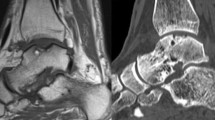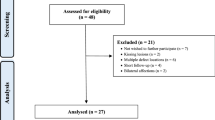Abstract
Purpose
To evaluate complication rates and postoperative outcomes in patients with osteochondral lesions of the talus who underwent an autologous matrix-induced chondrogenesis (AMIC) procedure with autologous spongiosa grafting without malleolar osteotomy.
Methods
A total of 23 patients with a mean age of 35.6 ± 13.9 years were included in this study. The mean follow-up was 33.5 ± 10.4 months (range 24–52.9 months). The clinical outcomes were evaluated using the visual analog scale (VAS) and the Foot Function Index (FFI). Postoperatively, lesion healing was assessed using the magnetic resonance observation of cartilage repair tissue (MOCART) protocol.
Results
There were no intraoperative or perioperative complications. In one patient, arthroscopic arthrolysis was performed due to painful arthrofibrosis. The mean VAS significantly decreased from 7.6 ± 1.1 (range 4.2–9.3) to 1.4 ± 2.2 (range 0–7.4) (P < 0.001). The mean FFI significantly improved from 46.8 ± 14.3 (range 24.3–80.8) to 15.9 ± 11.4 (range 10.0–51.7) (P < 0.001). The mean MOCART score at 1-year follow-up was 74.1 ± 12.4 (range 50–95). Both preoperative and postoperative pains were significantly higher for smokers when compared to non-smokers.
Conclusions
The results of the present study study indicate that AMIC procedure can be performed through the anterolateral and anteromedial arthrotomy without malleolar osteotomy. Thus, the possible complications associated with malleolar osteotomy can be avoided. The AMIC procedure without a malleolar osteotomy can be considered a safe and reliable procedure in patients with osteochondral lesions localized anterior to the midline in the sagittal plane.
Level of evidence
Therapeutic case series, Level IV.



Similar content being viewed by others
References
Amendola A, Panarella L (2009) Osteochondral lesions: medial versus lateral, persistent pain, cartilage restoration options and indications. Foot Ankle Clin 14:215–227
Barg A, Harris MD, Henninger HB, Amendola RL, Saltzman CL, Hintermann B et al (2012) Medial distal tibial angle: comparison between weightbearing mortise view and hindfoot alignment view. Foot Ankle Int 33:655–661
Barg A, Pagenstert G, Leumann A, Valderrabano V (2013) Malleolar osteotomy–osteotomy as approach. Orthopade 42:309–321
Budiman-Mak E, Conrad KJ, Roach KE (1991) The foot function index: a measure of foot pain and disability. J Clin Epidemiol 44:561–570
Dahmen J, Lambers KTA, Reilingh ML, van Bergen CJA, Stufkens SAS, Kerkhoffs G (2017) No superior treatment for primary osteochondral defects of the talus. Knee Surg Sports Traumatol Arthrosc. https://doi.org/10.1007/s00167-017-4616-5
de Leeuw PA, Golano P, Clavero JA, van Dijk CN (2010) Anterior ankle arthroscopy, distraction or dorsiflexion? Knee Surg Sports Traumatol Arthrosc 18:594–600
Ferreira C, Vuurberg G, Oliveira JM, Espregueira-Mendes J, Pereira H, Reis RL et al (2016) Good clinical outcome after osteochondral autologous transplantation surgery for osteochondral lesions of the talus but at the cost of high rate of complications: a systematic review. JISAKOS 0:1–8
Galla M, Lobenhoffer P (2011) Technique and results of arthroscopic treatment of posterior ankle impingement. Foot Ankle Surg 17:79–84
Georgiannos D, Bisbinas I, Badekas A (2016) Osteochondral transplantation of autologous graft for the treatment of osteochondral lesions of talus: 5- to 7-year follow-up. Knee Surg Sports Traumatol Arthrosc 24:3722–3729
Giza E, Sullivan M, Ocel D, Lundeen G, Mitchell ME, Veris L et al (2010) Matrix-induced autologous chondrocyte implantation of talus articular defects. Foot Ankle Int 31:747–753
Hepple S, Winson IG, Glew D (1999) Osteochondral lesions of the talus: a revised classification. Foot Ankle Int 20:789–793
Huskisson EC (1974) Measurement of pain. Lancet 2:1127–1131
Jung HG, Kim NR, Jeon JY, Lee DO, Eom JS, Lee JS et al (2017) CT arthrography visualizes tissue growth of osteochondral defects of the talus after microfracture. Knee Surg Sports Traumatol Arthrosc 26:2123–2130
Kubosch EJ, Erdle B, Izadpanah K, Kubosch D, Uhl M, Sudkamp NP et al (2016) Clinical outcome and T2 assessment following autologous matrix-induced chondrogenesis in osteochondral lesions of the talus. Int Orthop 40:65–71
Landis JR, Koch GG (1977) The measurement of observer agreement for categorical data. Biometrics 33:159–174
Lee KT, Kim JS, Young KW, Lee YK, Park YU, Kim YH et al (2013) The use of fibrin matrix-mixed gel-type autologous chondrocyte implantation in the treatment for osteochondral lesions of the talus. Knee Surg Sports Traumatol Arthrosc 21:1251–1260
Leumann A, Horisberger M, Buettner O, Mueller-Gerbl M, Valderrabano V (2016) Medial malleolar osteotomy for the treatment of talar osteochondral lesions: anatomical and morbidity considerations. Knee Surg Sports Traumatol Arthrosc 24:2133–2139
Lindsjo U, Danckwardt-Lilliestrom G, Sahlstedt B (1985) Measurement of the motion range in the loaded ankle. Clin Orthop Relat Res 199:68–71
Muir D, Saltzman CL, Tochigi Y, Amendola N (2006) Talar dome access for osteochondral lesions. Am J Sports Med 34:1457–1463
Polat G, Ersen A, Erdil ME, Kizilkurt T, Kilicoglu O, Asik M (2016) Long-term results of microfracture in the treatment of talus osteochondral lesions. Knee Surg Sports Traumatol Arthrosc 24:1299–1303
Ross AW, Murawski CD, Fraser EJ, Ross KA, Do HT, Deyer TW et al (2016) Autologous osteochondral transplantation for osteochondral lesions of the talus: does previous bone marrow stimulation negatively affect clinical outcome? Arthroscopy 32:1377–1383
Usuelli FG, de Girolamo L, Grassi M, D’Ambrosi R, Montrasio UA, Boga M (2015) All-arthroscopic autologous matrix-induced chondrogenesis for the treatment of osteochondral lesions of the talus. Arthrosc Tech 4:e255–e259
Valderrabano V, Miska M, Leumann A, Wiewiorski M (2013) Reconstruction of osteochondral lesions of the talus with autologous spongiosa grafts and autologous matrix-induced chondrogenesis. Am J Sports Med 41:519–527
van Bergen CJ, Tuijthof GJ, Blankevoort L, Maas M, Kerkhoffs GM, van Dijk CN (2012) Computed tomography of the ankle in full plantar flexion: a reliable method for preoperative planning of arthroscopic access to osteochondral defects of the talus. Arthroscopy 28:985–992
VanTienderen RJ, Dunn JC, Kusnezov N, Orr JD (2017) Osteochondral allograft transfer for treatment of osteochondral lesions of the talus: a systematic review. Arthroscopy 33:217–222
Verghese N, Morgan A, Perera A (2013) Osteochondral lesions of the talus: defining the surgical approach. Foot Ankle Clin 18:49–65
Verhagen RA, Struijs PA, Bossuyt PM, van Dijk CN (2003) Systematic review of treatment strategies for osteochondral defects of the talar dome. Foot Ankle Clin 8:233–242
Wiewiorski M, Barg A, Valderrabano V (2013) Autologous matrix-induced chondrogenesis in osteochondral lesions of the talus. Foot Ankle Clin 18:151–158
Wiewiorski M, Barg A, Valderrabano V (2013) Chondral and osteochondral reconstruction of local ankle degeneration. Foot Ankle Clin 18:543–554
Wiewiorski M, Werner L, Paul J, Anderson AE, Barg A, Valderrabano V (2016) Sports activity after reconstruction of osteochondral lesions of the talus with autologous spongiosa grafts and autologous matrix-induced chondrogenesis. Am J Sports Med 44:2651–2658
Young KW, Deland JT, Lee KT, Lee YK (2010) Medial approaches to osteochondral lesion of the talus without medial malleolar osteotomy. Knee Surg Sports Traumatol Arthrosc 18:634–637
Zengerink M, Struijs PA, Tol JL, van Dijk CN (2010) Treatment of osteochondral lesions of the talus: a systematic review. Knee Surg Sports Traumatol Arthrosc 18:238–246
Zengerink M, van Dijk CN (2012) Complications in ankle arthroscopy. Knee Surg Sports Traumatol Arthrosc 20:1420–1431
Acknowledgements
We thank Maxwell Weinberg, BS (Department of Orthopaedics, University of Utah, Salt Lake City, UT) for his help with manuscript correction and editing review.
Funding
None.
Author information
Authors and Affiliations
Corresponding author
Ethics declarations
Conflict of interest
The authors declare that they have no conflict of interest.
Ethical approval
The institutional review board (Ärztekammer Niedersachsen, 059/2015) approved this retrospective study, and informed consent was waived.
Electronic supplementary material
Below is the link to the electronic supplementary material.
Rights and permissions
About this article
Cite this article
Galla, M., Duensing, I., Kahn, T.L. et al. Open reconstruction with autologous spongiosa grafts and matrix-induced chondrogenesis for osteochondral lesions of the talus can be performed without medial malleolar osteotomy. Knee Surg Sports Traumatol Arthrosc 27, 2789–2795 (2019). https://doi.org/10.1007/s00167-018-5063-7
Received:
Accepted:
Published:
Issue Date:
DOI: https://doi.org/10.1007/s00167-018-5063-7




